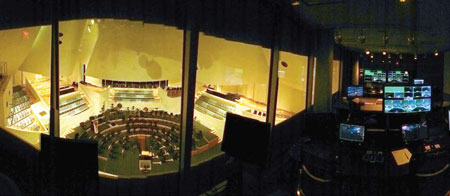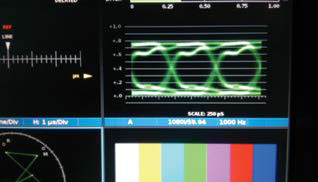4K Is Becoming a Reality for New World Symphony
New World Symphony is a higher education music institution located in Miami Beach, Fla., in a six year-old, Frank Gehry-designed building. New World makes every attempt to lead in technology in relation to music, performances, and education.

This summer, New World Symphony will replace 12 internal cameras and robotics with 4K cameras and more advanced robotics.
The facility includes distance learning technology, an HD cable system, video editing and production, and large format projection. Part of the technology includes the ability to record concerts in full HD via 10 robotic cameras, two manual, and numerous miniature cameras. Some of these concerts are called “Wallcast” concerts where the output of the switcher is fed to three Christie 35,000 lumen projectors which display on a small portion on the front of the facility (measuring 100x60-feet) and supported with over 130 Meyer speakers for a true “in hall” experience... but from outside in our park.
TWO-PHASE PLAN FOR 4K
Just over a year ago the outside park projectors were replaced with 4K units, but the technology really wasn’t developed enough to do anything real with 4K. At this point, we decided that the technology is there to push the signal to 4K, so a two-phase plan is in place to try to accomplish this.
Test Your Video Engineering Knowledge
I recently had the need to test prospective employees for an assistant video engineer position. Searching for some sort of test via the web didn’t help, so I created the following to gauge what my job candidates knew and understood. The last question relates to the need for engineers who understand good customer service. All of the candidates were told about this book and how I felt, so I figured it would be a good way to know who took it to heart. 1. Your Name? (note… if you miss this question, no need to continue!) 2. What is a video patch bay typically used for? In a standard two-row configuration, what sources are on the top row and what are on the bottom? 3. What is this and what does it represent?4. What two sorts of connections are typically needed between a TV camera and traditional broadcast switcher (one which does not have frame syncs) as a bare minimum? 5. What is the current aspect ratio of a TV picture? 6. What is the difference between 1080i and 720p? 7. What is the difference between 4K and UHD? 8. What is a frame sync used for and what is the difference between a frame sync and proc amp? 9. What kind of settings might you find on a frame sync like an AJA FS1 or FS2? 10. How might you sync the output of a computer before feeding it to a video switcher? Are there any other special considerations? 11. What is an audio embedder and de-embedder when it comes to HD video? Are there typically any settings to this equipment? 12. What is lip-sync error? 13. What would you use a waveform monitor and vectorscope for? 14. What do Iris and Pedestal control? (What do they affect?) 15. What is a TDR and how is it used? 16. Name some differences between single mode fiber and multi-mode fiber? 17. What precautions should you take when working with fiber optics? 18. What is Program, Preview, and M/E and where might you see it? 19. What is a terminator? What is the impedance of SDI/digital video? 20. What is the difference between digital audio unbalanced and balanced? 21. What are the bit rates of SDI video, of HDSDI, and of 4K video? 22. What is a multi-image display and how is it used? 23. Name as many types “video outputs” (the physical connections) on computers you can (both Mac & PC)? 24. What is a balun and how is it used? 25. What is the name of the main character in “Raving Fan: A Revolutionary Approach to Customer Service” and what is the award called?
Phase one takes place this summer which will include replacing 12 internal cameras and robotics with 4K cameras and more advanced robotics. We are currently evaluating cameras from major players in the industry but the decision on who to go with isn’t easy.
Get the TV Tech Newsletter
The professional video industry's #1 source for news, trends and product and tech information. Sign up below.
Here’s what I’m seeing with cameras: There seems to be two general varieties of 4K cameras, those which use numerous HD or better chipsets to create the 4K image, and those with a new 4K chipset. There’s a lot of debate between a “real 4K chip” and combining other “nearly 4K” chipsets, but if you base your decision on picture quality, most people won’t know the difference. We actually recorded images using a 4K recorder and dumped it (as 4K) into Adobe Premiere, then electronically magnified the image with test charts and were surprised to see the “non-true 4K” chips were showing much greater detail on test charts! Visually, different camera manufacturers have their own unique “paint job” (visual look), but that then seems to fall under “preference,” and most cameras can be painted any way you want them to look.
QUIET, PLEASE
In addition to the camera’s video output quality, New World is unique in the sense that the cameras must be dead quiet. One caveat to 4K (and I’m sure 8K) is the amount of processing power generates significant heat. Most 4K cameras appear to have cooling fans, but these can be switched off in an indoor environment (like our performance hall). This same “acoustic consideration” is actually more critical to the robotic system for camera movements. Any robotic system must pass muster with our audio director; it’s not just the loudness but even the actual “pitch” of the sound generated.
One of the most difficult aspects of “bleeding edge technology” is the current real lack of standardization on for signal transport. Will it be quad link BNC (four individual cables with 3G BNC connectors), like the first generation? Will it be IP and over some form of Cat6 with a RJ45? Fiber? Could it be dual-link 6G on two BNC’s, or even another single form of 12G connection to handle 4K/UHD? With no present standard defined on format or connector, 4K’s delivery method remains to be seen. Of course, new technology has often required defined standards and unfortunately 4K is no different.
We began evaluating robotic systems at the 2015 NAB Show and were really surprised that a few major player demos were far from what were expected (disappointing). With any robotic system, the idea is to do the same or better as you could with a live camera operator. In at least one demo, the camera shook, bounced, and did anything but perform smoothly (and that included going to a second set-up robotic system which performed the same). One feature we’re putting emphasis on having is multiple targeted shots within the same recall. Our present system limits us to the shot start point and end point only, but advanced shot composition requires a key-frame editing system where multiple shots are plotted and carried out through robotic animation with a “natural human feel” to the motion. But some we’re evaluating actually target numerous points for all movements including lens functions. All in all, the improvement in camera robotics in the past six years is phenomenal in many respects.

Phase two of our 4K project will include a completely new tech core comprised of eight racks. There are many considerations at play when working in a concert hall, most notably is noise! The HVAC system for the racks, their location, the impact to the performance hall, and heat output is at the top of the list. As the building is relatively new, power is less of a concern (though certainly weighing in). In addition to the tech core, a new 4K switcher and 4K recording/playback will be added.
In most cases for us, 4K will require the replacement of a lot of gear. One place I plan to “recycle” will be our multi-image display system, which will continue to be used for HD monitoring of the 4K signals, but supplemented with 4K preview and program monitors.
